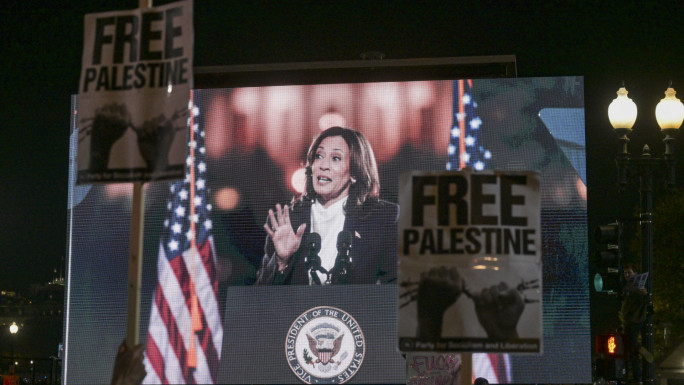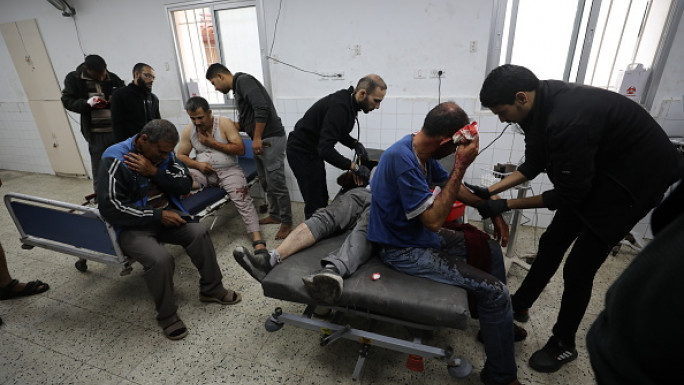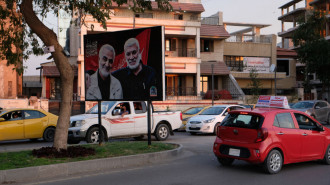Yemen's Houthi rebels unveil 'new and improved' ballistic missile
Yemen's Houthi rebels unveil 'new and improved' ballistic missile
A new and improved ballistic missile is now in the possession of the Yemeni rebels, a rebel-affiliated television in Yemen has claimed
2 min read
Yemen's rebels have repeatedly fired ballistic missiles into Saudi Arabia [File photo: AFP]
A new and improved ballistic missile is now in the possession of the Yemeni rebels, a rebel-affiliated television in Yemen has claimed, in conjunction with the escalation on multiple fronts in the country's ongoing civil war that has drawn in an intervention by Saudi Arabia and other Gulf Arab states.
The rebels comprise the Iran-backed Shia Houthis, officially known as Ansarullah, and army forces loyal to deposed President Ali Abdullah Saleh.
The Sanaa-based military manufacturing division controlled by the rebels unveiled the Burkan-1 (Volcano-1) ballistic missile, a locally upgraded Soviet-made SCUD, on Friday, according to a report carried by the Houthi-affiliated Al-Masira TV.
The upgraded missile has a range of over 800 km, the report claimed, and can hit further inside Saudi Arabia to repel the "aggression," said Al-Masira, in reference to the Saudi-led Arab coalition fighting the rebels alongside the internationally recognised government.
The missile is 12.5 meters long and has a diametre of 88 cm, the report said, describing it as a "game changer" that will force the Saudi-led coalition to reconsider its calculations.
Since the start of the Saudi-led Arab intervention in Yemen in March 2015, the Yemeni rebels claimed having manufactured several ballistic missile types locally, including Qaher-1 and Zelzal-1 and 2.
It is believed many of the upgraded missiles, in addition to SCUDs, come from Yemen's arsenal of rockets imported from the Soviet Union in the 1980s, developed into ballistic missile grade by the Houthi rebels, possibly with assistance from Iran and Lebanon's powerful Shia militia Hizballah.
In mid-August, a report carried by Iran's official news agency IRNA said one of the missiles fired by Houthis into Saudi Arabia was an Iranian-made Zelzal-3 rocket.
The Houthi rebels have repeatedly fired rockets into Saudi Arabia, most recently in August, but they have been often intercepted by anti-missile systems operated by the kingdom's army.
More than 10,000 have died since Saudi Arabia launched a military campaign against Houthis in Yemen, forcing more than three million to flee the conflict.
A UN-led initiative to bring an end to the 17-month war collapsed earlier this month, after three months of discussions.
The rebels comprise the Iran-backed Shia Houthis, officially known as Ansarullah, and army forces loyal to deposed President Ali Abdullah Saleh.
The Sanaa-based military manufacturing division controlled by the rebels unveiled the Burkan-1 (Volcano-1) ballistic missile, a locally upgraded Soviet-made SCUD, on Friday, according to a report carried by the Houthi-affiliated Al-Masira TV.
The upgraded missile has a range of over 800 km, the report claimed, and can hit further inside Saudi Arabia to repel the "aggression," said Al-Masira, in reference to the Saudi-led Arab coalition fighting the rebels alongside the internationally recognised government.
The missile is 12.5 meters long and has a diametre of 88 cm, the report said, describing it as a "game changer" that will force the Saudi-led coalition to reconsider its calculations.
Since the start of the Saudi-led Arab intervention in Yemen in March 2015, the Yemeni rebels claimed having manufactured several ballistic missile types locally, including Qaher-1 and Zelzal-1 and 2.
It is believed many of the upgraded missiles, in addition to SCUDs, come from Yemen's arsenal of rockets imported from the Soviet Union in the 1980s, developed into ballistic missile grade by the Houthi rebels, possibly with assistance from Iran and Lebanon's powerful Shia militia Hizballah.
In mid-August, a report carried by Iran's official news agency IRNA said one of the missiles fired by Houthis into Saudi Arabia was an Iranian-made Zelzal-3 rocket.
The Houthi rebels have repeatedly fired rockets into Saudi Arabia, most recently in August, but they have been often intercepted by anti-missile systems operated by the kingdom's army.
More than 10,000 have died since Saudi Arabia launched a military campaign against Houthis in Yemen, forcing more than three million to flee the conflict.
A UN-led initiative to bring an end to the 17-month war collapsed earlier this month, after three months of discussions.
Twitter Post
|





 Follow the Middle East's top stories in English at The New Arab on Google News
Follow the Middle East's top stories in English at The New Arab on Google News

![Observers view Trump as the most coinvent option for Egypt's Sisi in the current phase. [Getty]](/sites/default/files/styles/image_330x185/public/1141487775.jpeg?h=a5f2f23a&itok=S4AF0E0G)
